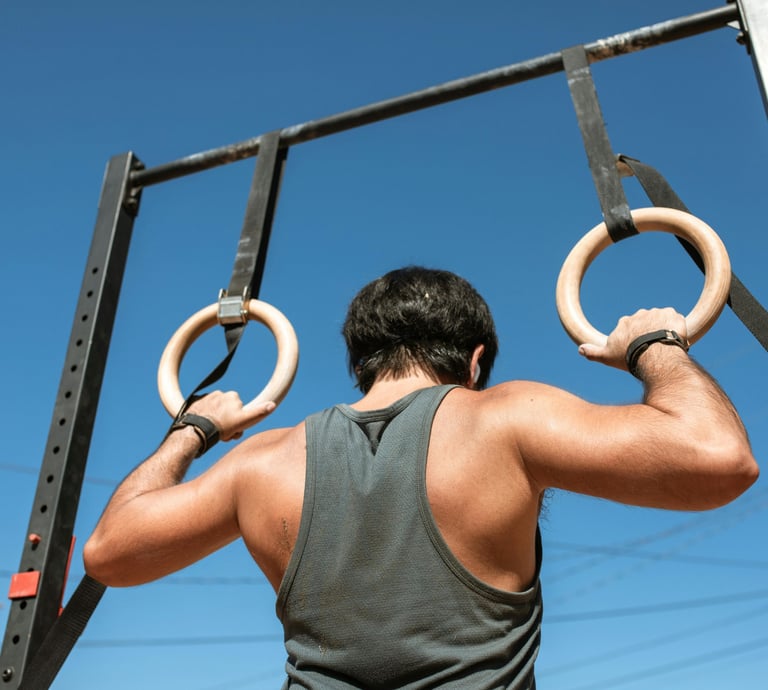OUT NOW: 8 WEEK TRANSFORMATION PROGRAM
Calisthenics vs. Weightlifting: Which is Better for Your Goals?
This blog compares calisthenics and weightlifting, highlighting their unique benefits and limitations.
WORKOUTS
12/21/20243 min read


The debate between calisthenics and weightlifting has gained traction in recent years as fitness enthusiasts explore the best ways to achieve their goals. Both modalities offer unique advantages and drawbacks, making the choice highly dependent on individual goals, preferences, and circumstances. This article examines the key differences, benefits, and limitations of each approach, supported by academic research and expert opinions.
Defining Calisthenics and Weightlifting
Calisthenics involves bodyweight exercises such as pull-ups, push-ups, and squats. It focuses on functional movements and requires minimal equipment, relying primarily on one’s body as resistance. This modality emphasizes control, balance, and overall body awareness (Yuri et al., 2017).
Weightlifting, on the other hand, uses external weights such as dumbbells, barbells, or resistance machines to build strength and muscle mass. This includes traditional exercises like bench presses, deadlifts, and squats, often performed in structured routines (Kraemer et al., 2002).
Benefits of Calisthenics
Improved Functional Strength
Calisthenics closely mimics natural movement patterns, improving mobility and coordination. Studies suggest that bodyweight exercises enhance proprioception and functional fitness, making them ideal for everyday activities (Frost et al., 2015).
Accessibility and Versatility
Without the need for gym equipment, calisthenics can be performed virtually anywhere, making it a cost-effective and flexible option.
Core Engagement
Many calisthenics exercises inherently involve the core, promoting stability and reducing the risk of injuries (Yuri et al., 2017).
Scalability
Exercises can be modified for beginners or advanced practitioners, such as progressing from knee push-ups to one-arm push-ups.
However, calisthenics may not be ideal for those aiming to maximize hypertrophy due to its reliance on bodyweight resistance, which can limit progressive overload


Benefits of Weightlifting
Muscle Hypertrophy
Weightlifting is particularly effective for increasing muscle size and strength. Progressive overload through increased weights is a proven strategy for hypertrophy (Schoenfeld, 2010).
Targeted Muscle Training
Unlike calisthenics, weightlifting isolates specific muscle groups, making it ideal for addressing imbalances or aesthetic goals.
Bone Density
Resistance training has been shown to improve bone mineral density, reducing the risk of osteoporosis (Kohrt et al., 2004).
Customization
With varied equipment and exercises, weightlifting programs can be tailored to specific goals, from strength to endurance.
Despite its benefits, weightlifting typically requires access to equipment and a proper understanding of technique to avoid injuries.


How to Choose: Goals and Considerations
1. Strength and Performance
Calisthenics excels in relative strength (strength-to-weight ratio) and functional movement patterns.
Weightlifting is superior for absolute strength and power, particularly in sports-specific contexts (Kraemer et al., 2002).
2. Muscle Growth
Weightlifting’s ability to isolate and overload muscles makes it the preferred choice for hypertrophy.
Advanced calisthenics can contribute to muscle growth, but progression is less linear.
3. Flexibility and Mobility
Calisthenics promotes mobility, benefiting athletes and those with sedentary lifestyles.
Weightlifting may limit mobility if not paired with stretching and proper technique.
4. Accessibility
Calisthenics is ideal for those without access to a gym or equipment.
Weightlifting often requires a gym membership.
Combining Both Modalities
For many, a hybrid approach offers the best of both worlds. Research indicates that combining bodyweight exercises with resistance training can improve strength, mobility, and hypertrophy simultaneously (Faigenbaum et al., 2009). For example, incorporating pull-ups alongside weighted squats provides a balanced training regimen.
What Can We Conclude?
Both calisthenics and weightlifting are effective fitness modalities, each with unique strengths. Calisthenics is ideal for functional strength, mobility, and accessibility, while weightlifting excels in muscle hypertrophy, absolute strength, and bone health. Your choice should align with your specific fitness goals, lifestyle, and preferences. Alternatively, blending the two can maximize benefits and offer a comprehensive approach to physical fitness.
References
Faigenbaum, A. D., et al. (2009). Youth Resistance Training: Updated Position Statement Paper from the National Strength and Conditioning Association. The Journal of Strength & Conditioning Research, 23(5), 60-79.
Frost, D. M., et al. (2015). The effects of whole-body vibration on proprioception and strength. Journal of Athletic Training, 50(1), 72-81.
Kohrt, W. M., et al. (2004). Effects of Exercise on Bone Density. Endocrinology and Metabolism Clinics, 33(2), 175-197.
Kraemer, W. J., et al. (2002). Resistance Training for Health and Performance. Human Kinetics.
Schoenfeld, B. J. (2010). The Mechanisms of Muscle Hypertrophy and Their Application to Resistance Training. Journal of Strength and Conditioning Research, 24(10), 2857-2872.
Yuri, P., et al. (2017). Bodyweight Training: Principles and Applications for Personal Training. Strength and Conditioning Journal, 39(1), 90-96.
